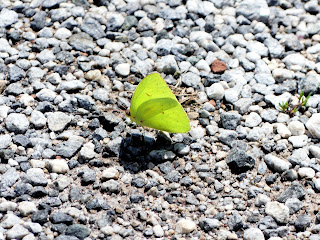Cloudless Sulphur
Here's another Cloudless Sulphur. I know I've shown them before, but the picture came out pretty good.
One webpage suggested that the name butterfly came from people observing a Cloudless Sulphur in flight and thinking it resembled a slab of flying butter. I was skeptical:
- I didn't think this species of butterfly was found in Eurasia (it isn't), so for this to be true English settlers would have needed to arrive in the Americas to name it, and this name would have needed to supplant whatever the English used to call butterflies.
- Although it's possible that a name inspired by a "flying slab of butter" could have occurred from some sulphur butterfly relative of the Cloudless Sulphur, it sounds at least as plausible that it came from a belief that butterflies ate milk/butter.
- And it seems possible that butterflies would try and drink nutrients from milk/butter. I've talked before about butterflies mud-puddling, a generic term for when they attempt to supplement their sugary nectar diets with nutrients found in mud, on scat, on rotting vegetation, and even decaying animals. (Nectar provides them with all the sugar they need, but a strong/healthy butterfly doesn't live on nectar alone.)
- You might also hear sometime that the name butterfly is a corruption of the term "flutter by", and that the latter was the original term for butterflies. Etymologists find no evidence for this notion.
 |
| August 17, 2020 at Duke Farms |



Comments
Post a Comment